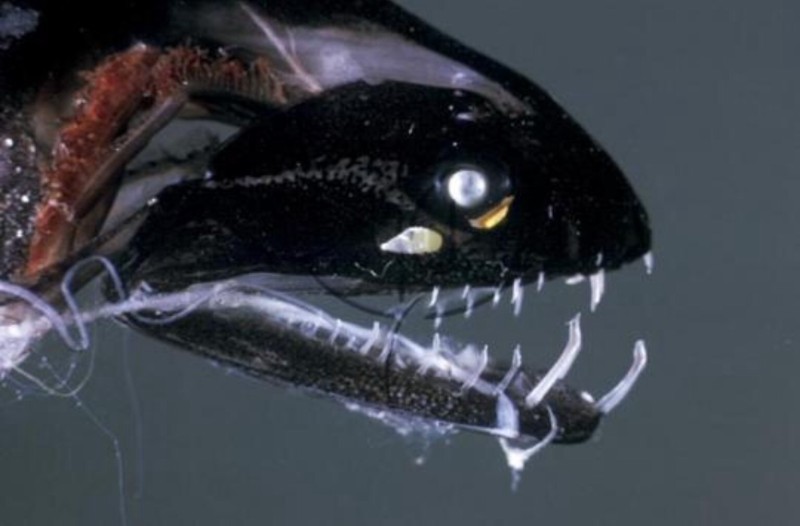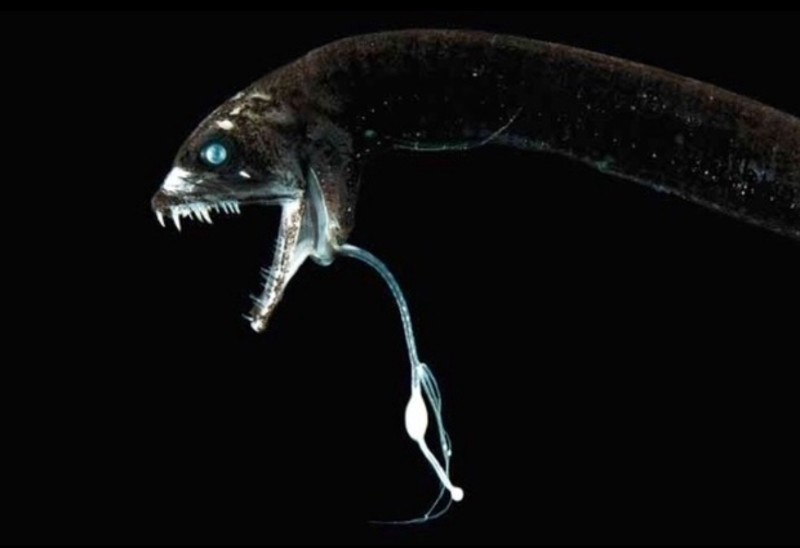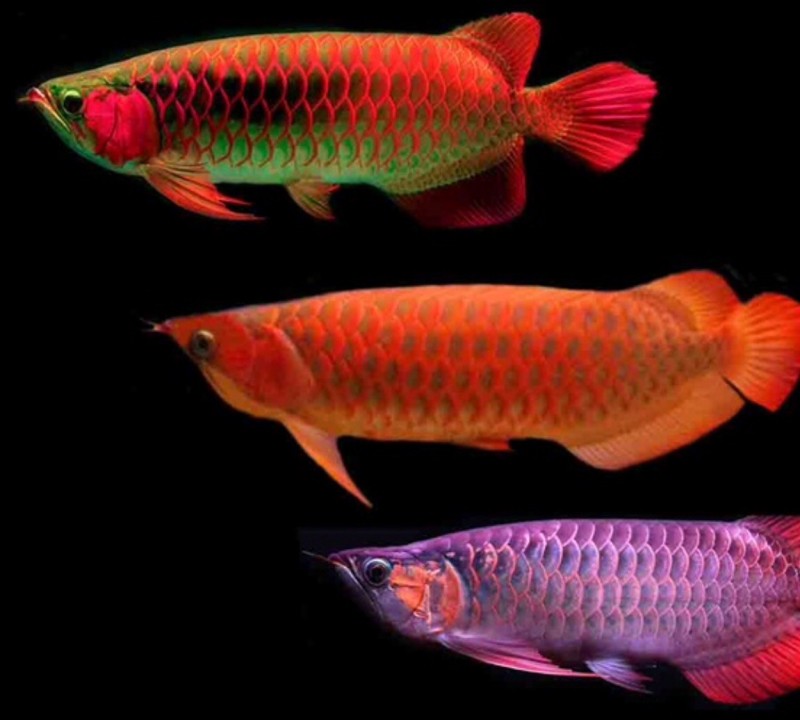What exactly is a Dragonfish? Well… any number of different species/types of fish actually — from a strange bioluminescent deep sea fish (Black Dragonfish), to a weird sea dragon looking thing that pair-bonds for life (sea moths), to an eel looking fish that you can actually raise on land so long as you keep them moist (Senegal Bichir), to a freshwater fish species that looks, in many ways, unchanged from how it looked during the times of the dinosaurs (Arowana).
While the focus of this article will be on the (perhaps) most recognizable of these fish — the deep sea Black Dragonfish — an overview of the other “Dragonfish” fish species will be given as well. Enjoy.
The Black Dragonfish
The Black Dragonfish (Idiacanthus atlanticus) is a species of barbeled dragonfish classified as being in the family Stomiidae. It’s found all over the world (circumglobally) in temperate or subtropical waters — typically between the latitudes of 25°S and 60°S. As mentioned before it lives quite deep — and can be found as far down as 6600 feet below the surface of the ocean.
Black Dragonfish grow, on average, to be up to a foot and a half long — but, as with some other deep sea fish, the females are notably bigger than the males.
Black dragonfish are bioluminescent, which in deep sea fish certainly isn’t that rare, but… In contrast to practically any other species out there, the black Dragonfish produces light that straddles the border of the infrared part of electromagnetic spectrum.
As a result, with just the naked eye people don’t see much of the light produced by the black Dragonfish — just a very limited portion of the spectrum being produced by the fish.
In common with humans, most fish can’t see in this part of the spectrum either, but the black Dragonfish can. Giving it a light to hunt by that’s invisible to most others — perfect for the deep, dark depths of the oceans where it lives.
While the Black Dragonfish is probably the best known of the various types of fish commonly known as dragonfish, it seems worth going over some of the other species referred to by that name as well here — the sea moths, the Arowana, and the Senegal Bichir, in particular.
Sea Moths (Dragonfish)
The sea moths are a family of fishes (Pegasidae) classified as being in the order Gasterosteiformes. They are, as you may have guessed, named after a mythological figure that they look a fair amount like — Pegasus.
They are probably one of the most distinct looking animals, of any type, out there. They are often referred to as dragonfish owing to their ‘winged’ appearance — the large, pectoral fins that give the impression of flying through the water. Actually though, they use these to walk along the bottom of the ocean, where they live — so they’re a bit more like legs really.
A couple of quick, interesting facts: they are toothless; they are found mostly in the tropical waters of the Indo-Pacific; they ‘suck’ their food (worms, etc) out of the burrows where they live; they molt regularly (up to once a week); they practice monogamy and typically pair-bond for life; and they live in low population densities.
Not much is known about the current state of the various species, but one (Pegasus laternarius) is for sure known to be ‘threatened’ — with the others in questionable circumstances as well. Bottom trawling, use in “traditional Chinese medicine”, and the aquarium/fish trade, are all thought to be major threats to the survival of the various species.
Asian Arowana (Dragonfish)
The Asian arowana (Scleropages formosus) is a type (comprised of many phenotypic varieties) of freshwater fish that’s found throughout parts of Southeast Asia. While all Asian Arowana are considered by most to be a single species, there is some debate about this. The species is commonly known as a ‘dragonfish’ — owing to its resemblance to the mythological Chinese dragon.
The Arowana are known to mostly inhabit what are known as ‘blackwater rivers’ — which are essentially just slow moving rivers filled up with leached organic materials (tannins, etc). Think of forested swamps, wetlands, etc. Adults are carnivores, while younger ones feed mostly on insects.
Their spread throughout the islands of southeast Asia suggests they diverged from other osteoglossids before the continental breakup was complete. Genetic studies have confirmed this hypothesis, showing the ancestor of the Asian arowanas diverged from the ancestor of the Australian arowanas, S. jardinii and S. leichardti, about 140 million years ago, during the Early Cretaceous period. This divergence took place in the eastern margin of Gondwanaland, with the ancestors of Asian arowanas carried on the Indian subcontinent or smaller landmasses into Asia. The morphological similarity of all Scleropages species shows little evolutionary change has taken place recently for these ancient fish.
Asian arowanas typically grow to be up yo several feet long — and possess fairly robust bodies. The scales of the species are quite distinct — being quite large, cycloid, and often metallic looking.
The fish take a fair amount of time forward maturity, and don’t start producing offspring generally until their 3rd of 4th year of life. The females also don’t produce all that many eggs — as compared to many fish species. Their eggs are quite large though.
Interestingly, the species shows quite a lot of parental care — with paternal mouthbrooding of the larvae and eggs being the norm.
The species currently listed as being endangered by the IUCN Red List — primarily as a result of habitat loss, the wildlife/aquarium trade, and overfishing. The species is apparently quite popular with collectors, many of whom are willing to pay top dollar for the species.
The red and gold varieties are the most highly endangered.
Senegal Bichir (Dragonfish)
The Senegal bichir (Polypterus senegalus) is a prototypical species of fish of the Polypterus genus. Commonly referred to a “dinosaur eel” or a dragonfish, the fish is quite distinct looking.
Interestingly, the species possesses a pair of simple lungs — rather than a swim bladder. This allows the species to get its air from the surface of the water when need be (low-oxygen water).
The Senegal bichir’s armor is apparently noted for being particularly effective, and as a result has been studied a fair amount with aim for improving body armor.
Perhaps the most notable thing about the fish is that so long as it’s skin is kept moist it can remain out of water indefinitely. Apparently it’s even possible to for the fish to be raised on land — where they rely on their pectoral fins to ‘walk’.
Well, those four fish — the Black Dragonfish, the sea moths, the Asian Arowana, and the Senegal Bichir — are the types/species most commonly referred to as ‘dragonfish’, more or less summing up the common use of the word in the world today. So I hope that this article illuminated the subject for those looking for a straight answer as to what exactly a ‘dragonfish’ is. Cheers.
Image Credit: NOAA; Public Domain; MBARI; Screen Capture
The post Black Dragonfish, Barbeled Deep Sea Fish (+Arowana, Sea Moths, & Senegal Bichir) appeared first on Science Heathen.

























